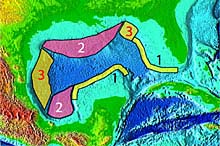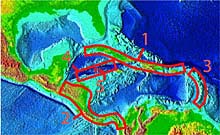
The slopes of the Gulf of Mexico are unlike those found in the adjacent Atlantic. In two areas (Type 1) there are steep carbonate escarpments. On the north and a bit on the south salt movement greatly influences the chemistry and geology (type 2). Only in the west and a small area of the northeast are “normal” deep habitats found (type 3). Click image for a larger view.
Geological Setting
Bob Carney
Louisiana State University
This expedition’s primary focus will be to explore and better understand bacteria and animal communities found where sulfide and/or methane are seeping from the deep-sea floor. Neither of these energy-rich compounds normally is abundant in the deep ocean. So their presence requires special geological processes. Therefore, we have a special interest in the geology of the Gulf of Mexico.
The slope of the Gulf displays three general types of bottom. Very tall, steep cliffs called escarpments are on the east and south sides. We know that chemosynthetic communities exist at the base of the west Florida escarpment, and we suspect that they may be found off Yucatan. Across the northern Gulf and in the southwest corner, thick sediments are being sculpted by deep salt layers. We know that such areas have chemosynthetic communities. The rest of the Gulf slope on the west and a small bit in the northeast corner display more normal types of seafloor. The geology of the area suggests that no chemosynthetic communities will be found there, but we are not certain of this.

While the Gulf of Mexico is geologically passive, the region to the south is still very active. Five structures give an indication of geological history and active processes. Click image for larger view.
To understand the unusual geological structures found in the Gulf of Mexico, one should look at the Caribbean just to the south, and consider geological history on a larger scale. The precursor to today’s Gulf of Mexico first appeared as part of the young Atlantic when North America and Europe began rifting apart. Subsequent southward migration of Gondwana Land resulted in a large connection between the forming Atlantic and the older Pacific to the west. This opening began to form about 175 million years ago and continued to grow until about 100 million years ago. .
The ocean between North and South America was partially cut off from the Atlantic and completely cut off from the Pacific by two massive shifts of land. First, Cuba and Hispanola moved in from the Pacific and formed the eastern border of the Caribbean. Other continental fragments moved in later but stopped farther west, eventually creating Central America. These closures created the Gulf of Mexico and the adjacent Caribbean marginal basins of the Atlantic, altered gene flow between the oceans, and established the major current patterns that area still prevalent today.
While the Gulf is geologically inactive, the modern Caribbean and adjacent regions show strong evidence of continued plate tectonics. Above water, one can see the volcanic islands of the Aves arch separating the Caribbean from the Atlantic. On the northern end of this arch, the Puerto Rican trench lies on the Atlantic side. At the southern end lies the Barbados accretionary prism. An unusual feature of the Caribbean is the 6000-m deep Cayman Trough. The floor of this deep trough is quite complex. Although it is quite small, there is a spreading region at the bottom of the trough, and its ecology remains unexplored.
Sign up for the Ocean Explorer E-mail Update List.























